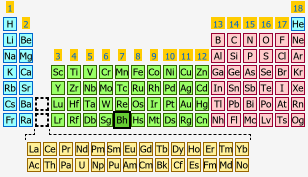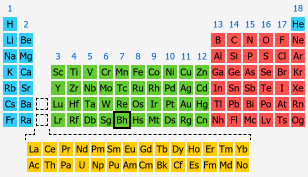References (Click the  next to a value above to see complete citation information for that entry)
next to a value above to see complete citation information for that entry)
Connelly, Neil G., Ture Damhus, Richard M. Hartshorn, and Alan T. Hutton.
Nomenclature of Inorganic Chemistry: IUPAC Recommendations 2005. Cambridge: RSC Publishing, 2005.
Cambridge: RSC Publishing, 2005.
Emsley, John. Nature's Building Blocks: An A-Z Guide to the Elements. Oxford: Oxford University Press, 2003.
Emsley, John. The Elements, 3rd edition. Oxford: Oxford University Press, 1998.
Firestone, Richard B. Table of Isotopes, 8th edition, volume 2. Edited by Virginia S. Shirley, with assistant editors Coral M. Baglin, S. Y. Frank Chu, and Jean Zipkin. New York: John Wiley & Sons, Inc., 1996.
Hoffman, Darleane C., Albert Ghiorso, and Glenn T. Seaborg. The Transuranium People: The Inside Story. London, England:
Imperial College Press, 2000.
Hofmann, S., V. Ninov, F. P. Heßberger, P. Armbruster, H. Folger, G. Münzenberg, H. J. Schött, A. G. Popeko, A. V. Yeremin, A. N. Andreyev, S. Saro, R. Janik, and M. Leino. "Production and Decay of 269110." Zeitschrift für Physik A Hadrons and Nuclei, volume 350, number 4, 1995, pp. 277–280. doi:10.1007/BF01291181
Hofmann, S., V. Ninov, F. P. Heßberger, P. Armbruster, H. Folger, G. Münzenberg, H. J. Schött, A. G. Popeko, A. V. Yeremin, A. N. Andreyev, S. Saro, R. Janik, and M. Leino. "The New Element 111." Zeitschrift für Physik A Hadrons and Nuclei, volume 350, number 4, 1995, pp. 281–282. doi:10.1007/BF01291182
Hofmann, S., V. Ninov, F. P. Heßberger, P. Armbruster, H. Folger, G. Münzenberg, H. J. Schött, A. G. Popeko, A. V. Yeremin, S. Saro, R. Janik, and M. Leino. "The New Element 112." Zeitschrift für Physik A Hadrons and
Nuclei, volume 354, number 3, 1996, pp. 229–230. doi:10.1007/s002180050036
Keller, Jr., O. Lewin, and Glenn T. Seaborg. "Chemistry of the Transactinide Elements." pp. 139–166 in Annual Review Of Nuclear Science. Edited by Emilio Segre. Palo Alto, California: Annual Reviews Inc., 1977.
Krause, M. O. "Atomic Radiative and Radiationless Yields for K and L Shells." Journal of Physical and Chemical Reference Data, volume 8,
number 2, 1979, pp. 307–327.
Journal of Physical and Chemical Reference Data, volume 8,
number 2, 1979, pp. 307–327.
Miessler, Gary L., and Donald A. Tarr. Inorganic Chemistry, 3rd edition. Upper Saddle River, NJ: Pearson Prentice Hall, 2004.
Münzenberg, G., P. Armbruster, F. P. Heßberger, S. Hofmann, K. Poppensieker, W. Reisdorf, J. H. R. Schneider, W. F. W. Schneider, K.-H. Schmidt, C.-C. Sahm, and D. Vermeulen. "Observation of One Correlated α-Decay in the Reaction 58Fe on 209Bi → 267109." Zeitschrift für Physik A Hadrons and Nuclei, volume 309, number 1, 1982, pp. 89–90. doi:10.1007/BF01420157
Münzenberg, G., P. Armbruster, H. Folger, F. P. Heßberger, S. Hofmann, J.
Keller, K. Poppensieker, W. Reisdorf, K.-H. Schmidt, H.-J. Schött, M. E. Leino, and R. Hingmann. "The Identification of Element 108." Zeitschrift für Physik A Hadrons and Nuclei, volume 317, number 2, 1984, pp. 235–236. doi:10.1007/BF01421260
Münzenberg, G., S. Hofmann, F. P. Heßberger, W. Reisdorf, K. H. Schmidt, J. H. R. Schneider, P. Armbruster, C. C. Sahm, and B. Thuma. "Identification of Element 107 by α Correlation Chains." Zeitschrift für Physik A Hadrons and Nuclei, volume 300, number 1, 1981, pp. 107–108. doi:10.1007/BF01412623
Pekka Pyykkö. Self-Consistent, Year-2009 Covalent Radii. http://www.chem.helsinki.fi/~pyykko/Radii09.pdf . Accessed on November 20, 2010.
. Accessed on November 20, 2010.
Pyykkö, Pekka, and Michiko Atsumi. "Molecular Double-Bond Covalent Radii for Elements Li-E112." Chemistry - A European Journal, volume 15, number 46, 2009, pp. 12770–12779. doi:10.1002/chem.200901472
Pyykkö, Pekka, and Michiko Atsumi. "Molecular Single-Bond Covalent Radii for Elements 1-118." Chemistry - A European Journal, volume 15, number 1, 2009, pp. 186–197. doi:10.1002/chem.200800987
Pyykkö, Pekka, Sebastian Riedel, and Michael Patzschke. "Triple-Bond Covalent Radii." Chemistry - A European Journal, volume 11, number 12, 2005, pp. 3511–3520. doi:10.1002/chem.200401299
Seaborg, Glenn T., and Walter D. Loveland. The Elements Beyond Uranium. New York: John Wiley & Sons, Inc., 1990.
Soukhanov, Anne H., editor. The American Heritage Dictionary Of The English Language, 3rd edition. Boston: Houghton Mifflin Company, 1992.
Yaws, Carl L. The Yaws Handbook of Physical Properties
for Hydrocarbons and Chemicals. Houston, TX: Gulf Publishing Company, 2005.







































 next to a value above to see complete citation information for that entry)
next to a value above to see complete citation information for that entry) Cambridge: RSC Publishing, 2005.
Cambridge: RSC Publishing, 2005.


 Journal of Physical and Chemical Reference Data, volume 8,
number 2, 1979, pp. 307–327.
Journal of Physical and Chemical Reference Data, volume 8,
number 2, 1979, pp. 307–327.


 . Accessed on November 20, 2010.
. Accessed on November 20, 2010.




